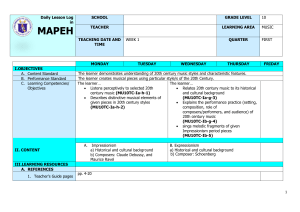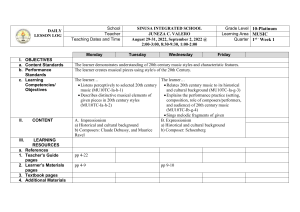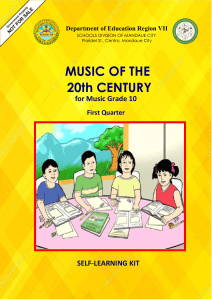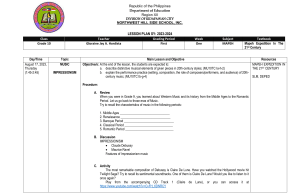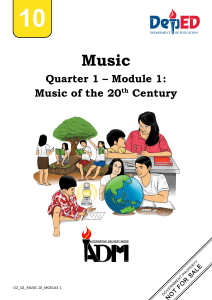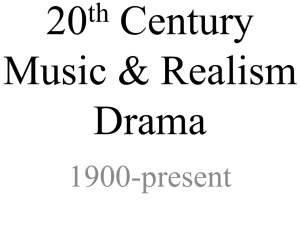pdf-music-10-quarter-1-module-1-3-pdf-free-answered compress
advertisement
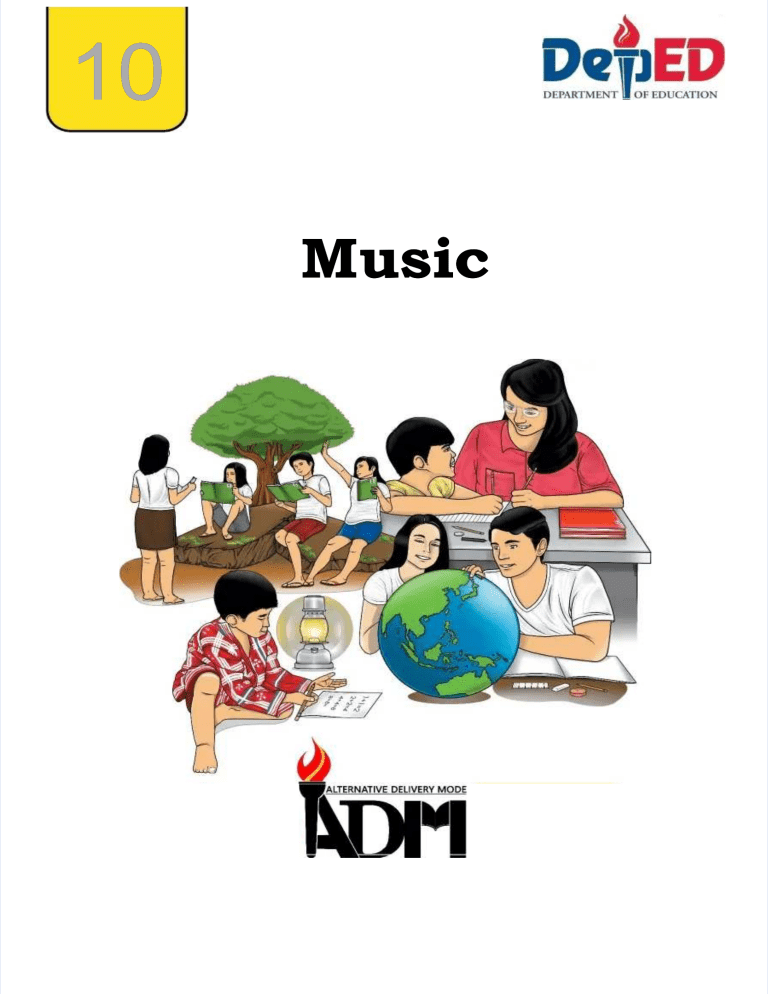
10 Music 10 Music Quarter 1 – Module 1: Music of the 20th Century Music – Grade 10 Al ter nativ nat iv e Deliv ery Mode Mod e Quarter 1 – Module 1: Music Music of t he 20th Century First Editi on, 2020 2020 Republic Act 8293, section 176 states that: No copyright shall subsist in any work of the Government of the Philippines. However, prior approval of the government agency or office wherein the work is created shall be necessary for exploitation of such work for profit. Such agency or office may, among other things, impose as a condition the payment of royalties. Borrowed materials (i.e., songs, stories, poems, pictures, photos, brand names, trademarks, etc.) included in this module are owned by their respective copyright holders. Every effort has been exerted to locate and seek permission to use these materials from their respective copyright owners. The publisher and authors do not represent nor claim ownership over them. Published by the Department of Education Secretary: Leonor Magtolis Briones Undersecretary: Diosdado M. San Antonio Development Team of the Module Writer: Sherween F. Cabrales Editors: Sherberk F. Cabrales, Luzviminda T. Sagario , Regina Genelin C. Nagtalon Reviewers: Arsendio A. Cabacungan, Francis A. Domingo , Adelyn C. Domingo Antonio V. Laceste, Jr., Editha T. Giron , Gina A. Amoyen Illustrator: Abraham S. Salvador Layout Artist: Roger C. Vea Management Team: Tolentino G. Aquino Vilma D. E Eda da Arlene A. Niro Joye D. Madalipay Editha T. Giron Adelyn C. Domingo Gina A. Amoyen Arsendio A. Cabacungan Francis A. Domingo Marlyn S. Ventura Printed in the Philippines by:______________ by:______________________________ __________________________ __________ Department of Education – Region 1 Office Address: Flores St., Catbangen, City of San Fernando, La Union Telefax: (072) 607-8137/ 6 682-2324 82-2324 E-mail Address: region1@depe region1@deped.gov.ph d.gov.ph What I Need to Know This module provides provides you the foundation of Music in the 20th century. In your journey through the discussions and different tasks, you are expected to: 1. describe distinctive musical elements of given pieces in 20th century styles; (MU10TC Ia-h-2) 2. explain the performance practice (setting, composition, role of composers/performers, and audience) of 20th century music; ( MU10TC Ib-g-4) 3. relate 20th Century music to other art forms and media during the same time period; (MU10TC Ia-g-3) 4. perform music sample from the 20th century; (MU10TC Ib-5) and 5. evaluate music and music performance performances s using guided rubrics. The module is divided divided into 3 lessons, na namely: mely: • • • Lesson 1 – Impressionism Lesson 2 – Expressionism Lesson 3 – 20th Century Musical Styles 1 What I Know Read the statements carefully and identify what is being described. Choose the letter that represents your best answer. Write your answer on a separate sheet of paper. 1. His technique in composition is the use of semi-tone scale. a. Cage b. Debussy c. Glass d. Schoenberg 2. It is the mark of the beginning of the Contemporary Period. a. Chance Music b. Expressionism c. Impressionism d. Jazz 3. This composer believes that “Because there is little sense of goal -directed motion, music does not seem to move from one place to another.” a. Cage b. Debussy c. d. Glass Schoenberg 4. Schoenberg Schoenberg experienced Triskaidekaph Triskaidekaphobia obia which is the fear of the number _. a. 11 b. 12 c. 13 d. 14 5. It is also known as Aleatory Music. a. Chance Music b. Expressionism c. Impressionism d. Jazz 6. It tends to make more use of dissonance and more uncommon scales such as the whole tone scale. a. Chance Music b. Expressionism c. Impressionism d. Jazz 7. It is a modern contemporary piano piece in Impressionism. a. Claire De Lune 2 b. c. d. Für Elise La Mer Sunrise 8. It is an experimental or downtown music originated in the US. a. Chance Music b. Expressionism c. Jazz d. Minimalism 9. Following are characteristics of Minimalism except _________. a. Minimal Time b. Reiteration of Motifs c. Slow Transformation d. Steady Pulse 10. He is known as one of the the 20th century comp composers osers with the wides widestt array of sounds in his works. a. Cage b. Debussy c. Glass d. Schoenberg 11. Alea in the word Aleatory means __________. a. Cube b. Dice c. Improvise d. Play 12. He is the Father of Modern Music. a. Cage b. c. d. Debussy Glass Schoenberg 13. He was the primary exponent of the impressionist movement and the focal point for other impressionist composers. a. Cage b. Debussy c. Glass d. Schoenberg 14. It is equal to a twelfth of an octave or a half tone. It is a half-step stone. a. Chromatic Scale b. c. Dissonant Semi Tone Scale 3 d. Whole Tone Scale 15. Music that uses the tape recorder is called _________________. a. Musique concrete b. Music saving c. Record tape d. Save Music Lesson Impressionism 1 What music do you usually listen to? Are you into Rock? Pop? Or Hip-hop music? I’m sure that you enjoy listening to these genres of music. Like any other products of modernization, these songs have gone through several phases of development. Come, let’s go down the memory lane and discover the roots of today’s music. The styles of modern songs can be traced back from the 20th Century. The innovative and experimental styles of the 20th Century Music are the influences of the genius composers such as Claude Debussy, Maurice Ravel, Arnold Schoenberg, Bela Bartok, Igor Stravinsky, Sergei Prokofieff, and George Gershwin. Coming from different nations such as France, Austria, Hungary, Russia, and the United States, these composers clearly reflect the growing globalization of musical styles in the 20th century. What’s In When you were in Grade 9, you learned about Western Music and its history from Middle Ages to the Romantic Period. Let us go back to those eras of Music. Try to recall the characte characteristics ristics of music in the following periods: 1. Middle Ages ______________________ _______________________________ _________ 2. Renaissance _______________________________ 3. Baroque Period _______________ _______________________________ ________________ 4. Classical Period ____________________ ______________________________ __________ 5. Romantic Period _________________ ______________________________ _____________ 4 Notes to the Teacher Please check the answers of the learner. If all answers are correct, the the learne learnerr will proceed to the next part of this module module.. the Otherwise, as sist the learner to recall facts about abovementioned periods for better understanding of the next lessons. As you continue your journey through the ages of music, you will get a view of how music has developed into what it is today. The First Quarter covers Music of the 20th Century which is also known as Contemporary Music. You will discover different movements in this period, meet the different composers and observe their distinct techniques and styles. What’s New IMPRESSIONISM As the world entered the 20th century, a new era in music was introduced and impressionism was one of the earliest musical forms that paved way to this modern era. Impressionism is a French movement in the late 19th and early 20th century. The sentiment sentimental al melodies and dramatic emotionalism of the preceding Romantic Period whose themes and melody are easy to recognize and enjoy, were being replaced in favor of moods and impressions. Features of Impressionism music are as follows: • • • The use of "color", or in musical terms terms,, timbre, which can be achieved through orchestration, harmonic usage, texture, etc. (Timbre is known as the tone color or tone quality) New combinations of extended chords, harmonies, whole tone, chromatic scales, and pentatonic scales emerged. Impressionism was an attempt not to depict reality, but merely to suggest it. 5 CLAUDE DEBUSSY (1862–1918) Claude Debussy was one of the most influential and leading composers of the 20 th century. He was the principal exponent of the impressionist movement and the inspiration for other impressionist composers. He reformed the course of musical development by eradicating traditional rules and conventions into a new language of possibilities in harmony, rhythm, form, texture, and color. Image from melhoresmusicasclassicas.c m in Sunico, et.al, 2015, p.5. He was born on August 22, 1862 in a small town called St. Germain-en-Layein in France. He composed a total of more or less 227 masterpieces which include orchestral music, chamber music, piano music, operas, ballets, songs, and other vocal music. He was known as the “Father of the Modern School of Composition” and made his impact in the styles of the later 20th century composer like Igor Stravinsky. Debussy’s mature creative period was exemplified by the following works: • • • • String Quartet La Mer (1905)-a highly imaginative and atmospheric symphonic work for orchestra about the sea Première Arabesque and nd most famous famous movement movement of Claire de Lune (Moonlight (Moonlight))-The third a Suite bergamasque. In the field of visual arts, Debussy was influenced by Monet, Pissaro, Manet, Degas, and Renoir; and from the literary arts, by Mallarme, Verlaine and Rimbaud. Most of his close friends were painters and poets who significantly influenced his works. On March 25, 1918, he died of cancer at the height of the First World War in Paris. What I Can Do The most remarkable remarkable composition of Debussy is Claire De Lu Lune. ne. Have y you ou watched the Hollywood movie hit Twilight Saga? Try to recall its sentimental sound tracks. One of them is Claire De Lune! Would you like to listen to it once again? Play from the accompanying CD Track 1 (Claire de Lune) or you can access it at https://www.youtube.com/watch?v=CvFH_6DNRCY. While listening to the track, answer the following guide questions. Use a separate sheet of paper. • • What musical instrument is being played? How did the music affect your mood or feelings in terms of the general atmosphere of the piece? 6 MAURICE RAVEL (1875–1937) Joseph Maurice Ravel was born in Ciboure, France to a Basque mother and a Swiss father. At age 14, he entered the Paris Conservatory where he was musically nurtured by a prominent French composer, Gabriel Faure. The compositional style of Ravel is mainly characterized by its distinctively innovative but not atonal style (music that is written in a way that is not based on any particular key) of harmonic treatment. Image from rateyourmusic.com in Sunico, et.al, 2015, p.7. His works are defined with intricate and sometimes modal melodies and extended chordal components. It demands considerable technical technical virtuosity from the performer which is the character, ability, or skill of a virtuoso—a person who is exemplary in musical technique or execution. Ravel’s works include the following: • • • • • Pavane for a Dead Princess (1899) String Quartet (1903) Sonatine for Piano (c.1904) Rhapsodie Espagnole Bolero Ravel was a perfectionist and every bit a musical craftsman. He strongly adhered to the classical form, specifically its ternary structure. A strong advocate of Russian music, he also admired the music of Chopin, Liszt, Schubert, and Mendelssohn. Mendelss ohn. He died in Paris in 1937. What I Can Do Ravel’s defining composition is “Bolero.” Bolero is a one -movement orchestral piece which was was premiered in 1928. Play from the acc accompanying ompanying CD Track 2 (Bolero) (Bolero) or you can access it a att https://www.youtube.com/watch?v=b5V31O8ll14 While listening, answer the following guide questions on a separate sheet of paper: • • What specific dance form can be performed with Bolero as music? What feelings or emotions does the music evoke? 7 What’s More COMPOSERS’ TABLE ACTIVITY. Fill out the table below by indicating the name of the artists and their works during the Impressionism Era and answer the question that follows. Please use a separate sheet of paper for your answers. Artists Works/Composition WRITING ACTIVITY. Which among the compositions of Impressionism inspired you most? Why? MUSIC LISTENING ACTIVITY. Play from the accompanying CD track 1 and write a 3-4 stanza poem inspired by the musical piece Claire de Lune. Lesson 2 Expressionism What’s In 8 It was an interesting start, right? Let’s continue to a more exciting journey in the world of music! In Lesson 1, you have learned that Impressionism was the first movement to be introduced during the 20th century. You also studied the life and works of some of the impressionist composers. Remember that the most distinctive feature of impressionism is the use of "color," or timbre in musical term which can be achieved through orchestration, harmonic usage, texture, etc. Impressionism reigned supreme for years until it was superseded by another style which is Expression Expressionism. ism. What’s New The term “Expressionism" was originally used in visual and literary arts and was probably first applied to music in 1918, especially to Schoenberg because like the painter Wassily Kandinsky ((1866 1866–1944), he veered away from "traditional forms of beauty" to convey powerful feelings in his music. Features of expressionism expressionism music are as follows: • • • • • a high degree of dissonance (dissonance is the quality of sounds that seems unstable) extreme contrasts of dynamics (from pianissimo to fortissimo, very soft to very loud) constant changing of textures "distorted" melodies and harmonies angular melodies with wide leaps ARNOLD SCHOENBERG (1874–1951) Arnold Schoenberg was born on September 13, 1874 in a working-class suburb of Vienna, Austria. He taught himself music theory but took lessons in Image from log.dataphilesmusic.com in Sunico, et.al, 2015, p.9. counterpoint. His works was greatly influenced by the German composer Richard Wagner as evident in his symphonic poem Pelleas et Melisande, Op. 5 (1903), a counterpoint of Debussy’s opera of the same title. Schoenberg’s style in music reformed from time to time. From the early influences of Wagner, his tonal preference gradually revolved to something dissonant and atonal, as he explored the use of chromatic harmonies. He was responsible for the establishment of the twelve-tone system. Twelve-tone system 9 His works include the following: Verklarte Nacht Three Pieces for Piano, op. 11 Pierrot Lunaire Violin Concerto Skandalkonzert, rt, a concert of the Wiener Konzertverein. Konzertverein. Skandalkonze • • • • • Although full of melodic and lyrical interest, his music was also extremely complex, creating heavy demands on the listener. He experienced Triskaidekaphobia (fear of number 13). Schoenberg died on July 13, 1951 in Los Angeles, California, USA where he had settled since 1934. What I Can Do One of the most significant compositions of Schoenberg is Three Piano Pieces, Op. 11. This musical piece was the first composition ever to dispense completely with “tonal” (counterp art of atonal) means of organization. Play from the accompanying CD Track 3 (Three Piano Pieces). Alternatively, you can access it at https://www.youtube.com/watch?v=xrjg3jzP2uI While listening, answer the following guide questions on a separate sheet of paper: What genre of movie can this music be used? What particular moment in your life does this music remind you of? • • IGOR STRAVINSKY (1882–1971) He was born in Oranienbaum (now Lomonosov), Russia on June 17, 1882. Stravinsky’s early music reflected the influence of his teacher, the Russian composer Nikolai RimskyKorsakov. But in his first notable composition “The Firebird Russian Suite which was composed for Diaghilev’s Ballet,(1910)” his skillful handling of material and rhythmic Image from 8notes.com in Sunico, et.al, 2015, p.11. inventiveness went beyond anything written by his Russian predecessors. He added a new ingredient to his nationalistic musical style. The Rite of Spring (1913) was another outstanding work showcasing his new technique. Other acclaimed works by Stravinsky includes: • • Ballet Petrouchka (1911), featuring shifting rhythms and polytonality, a signature device of the composer The Nightingale Nightingale (1914) • • • ThreeConcertant Tales for for Children Duo (1932) (1917) The Rake’s Progre Progress (1951), a full-length opera 10 Stravinsky wrote approximately 127 works, including concerti, orchestral music, instrumental music, operas, ballets, solo vocal, and choral music. Concerti or concerto is a musical composition for a solo instrument or instruments accompanied by an orchestra, especially one conceived on a relatively large scale. He died in New York City on April 6, 1971. What’s More MUSIC LISTENING ACTIVITY. From the CD, play track 4 (Petrouchka by Stravinsky) or access it at https://www.youtube.com/watch?v=OJRfImhtjq4 . After listening to the track, create an artwork inspired by Petrouchka using any contemporary contempora ry medium of arts. Use any paper available for your artwork. WORD HUNT. Encircle the words that are related to expressionist music in the grid below. The words run horizontally, ver vertically tically and diago diagonally. nally. S U S A D G E V O L D I S P T E I C L L E A A I E R V O O L R I R A O M N N H U Y L G N E A B C U H S C H O E N B E R G A S H M R A N R I U T N A R K S S T S H O A H A O R O I N N N Y A S G M A N I O A R U S S I A R A R L Y H C R E M T N A X S S D F G H I I A D I S T O R T E D C 11 Lesson 3 20th Century Musical Styles Now that you are familiar with Impressionism and Expressionism, you are ready to explore the very interesting musical forms of the 20th Century. Let’s discover the techniques and styles of Electronic and Chance Music. What’s In Expressionism is a style of music where composers seek to express emotional experience. For the next lesson, we will discuss the several musical styles that developed in the modern era. Some of these were short-lived, being experimental experimental and too radical in nature, while others found an active blend between the old and the new. New inventions and discoveries of science and technology led to continuing developments development s in the field of music. What’s New Technology Technolog y has been a game-change game-changerr in music. It has produced electronic music devices such as cassette tape recorders, compact discs and their variants, the video compact disc (VCD) and the digital video disc (DVD), MP3, MP4, digital music players, smart phones, karaoke players, and synthesizers. These devices are used for creating and recording music to add to or to replace acoustical sounds. ELECTRONIC MUSIC The ability of electronic machines such as synthesizers, synthesizers, amplifiers, tape recorders, and loudspeakers to produce different sounds was popularized by 20th century composers like Edgar Varese, Karlheinz Stockhausen, and Mario Davidovsky. that usesrecords the tape recorder is called concrete, or concrete music.Music The composer different sounds thatmusique are heard in the environment such as the bustle of traffic, the sound of the wind, the barking of dogs, the strumming of a guitar, or the cry of an infant. These sounds are arranged by the 12 composer in different ways like playing the tape recorder in its fastest mode or in reverse. In musique concrete, the composer is able to experiment with different sounds that cannot be produced by regular musical instruments such as the piano or the violin. The first electronic electronic devices for performing music were d developed eveloped at th the e end of the 19th century, and shortly afterwards, Italian futurists explored sounds that had not been considered musical. EDGARD VARÈSE (1883–1965) Born on December 22, 1883, Edgard (also spelled Edgar) Varèse was considered an “innovative French-born composer.” However, he spent his life and career mostly in the United States where he pioneered and created new sounds that bordered between music and noise. His musical compositions are characte characterized rized by: an emphasis on timbre and rhythm; and “organized sound” (certain timbres and rhythms can be grouped together in order to capture a whole new definition of sound). • Image from blogs.nmz.de in Sunico, et.al, 2015, p. 27. • Varèse’s use of new instruments and electronic resources made him the “Father of Electronic Music” and he was also dubbed as the “Stratospheric Colossus of Sound.” He died on November 6, 1965. What I Can Do Varèse’s Poème Électronique is one of the first compositions that was created through the use of technology. It’s an 8 -minute piece written in 1958. Varèse composed the piece with the intention of creating a liberation between sounds and as a result uses noises not usually considered “musical” throughout the piece. Play from the accompanying CD Track 5 ( Poème Électronique) or access it at https://www.youtube.com/watch?v=bEkjC76oSNk . While listening, answer the following guide questions on a separate sheet of paper: • • Can you guess the materials used to create the different types of noise used in the piece? Name at least 5. How does the piece affect your current mood or emotion? Describe. KARLHEINZ STOCKHAUSEN (1928– 2007) 13 Image from youtube.com in Sunico, et.al, 2015, p. 28. Karlheinz Stockhausen is a central figure in the realm of electronic music. music . Born in Cologne, Germany, he had the opportunity to work with Messiaen, Schoenberg, and Webern, the principal innovators at the time. Together with Pierre Boulez, Stockhausen drew inspiration from these composers as he developed his style of total serialism. Stockhausen’s music was initially met with resistance due to its heavily atonal content with practically no clear melodic or rhythmic sense. Still, he continued to experiment with musique concrete. Some of his works include: Gruppen (1957), a piece for three orchestras that moved music through time and space; Kontakte (1960), a work that pushed the tape machine to its limits; and Hymnen (1965), an ambitious two-hour work of 40 juxtaposed songs and anthems from around the world • • • • Licht (Light), a seven-part operasolo (oneinstruments, for each day of dancers, the week)choirs, for a gigantic ensemble of solo voices, solo orchestras, mimes, and electronics. It has led him to dream of concert halls in which the sound attacks the listener from every direction. Stockhausen’s works total around 31. What I Can Do Another popular electronic music composition is Studie II by Karlheinz Stockhausen. Play from the accompanying CD Track 6 ( Studie II) or access https://www.youtube.com/watch?v=_qi4hgT_d0o. While listening, answer the following guide questions on a separate sheet of paper: Where do you imagine yourself to be in while listening to the music? Why? • • What makes this track distinct from the other musical excerpts which you have heard heard so far far? ? CHANCE MUSIC Chance music also known as Aleatoric music refers to a style which the piece always sounds differently at every performance because of the random techniques of production, including the use of ring modulators or natural elements that become a part of the music. Most of the sounds emanate from the surroundings, both natural 14 and man-made, such as honking cars, rustling leaves, blowing wind, dripping water, or a ringing phone. An example of Chance music is John Cage’s Four Minutes and Thirty -Three Seconds (4’33") where the pianist merely opens the piano lid and keeps silent for the duration of the piece. The audience hears a variety of noises inside and outside the concert hall amidst the seeming silence. JOHN CAGE (1912–1992) John Cage was known as one of the 20th century composers with the broadest array of sounds in his works. He was born in Los Angeles, California, USA on September 5, 1912 and became one of the most original composers in the history of western music. Image from classicalscene.com in Sunico, et.al, 2015, p.30. He challenged the very idea of music by manipulating musical instruments in order to attain new sounds. He experimented with what came to be known as “chance music.” In one instance, Cage created a “prepared” piano, where screws and pieces of wood or paper were inserted between the piano strings to produce different percussive possibilities. He became notable for his work The Four Minutes and 33 Seconds (4’33"), a chance musical work that instructed the pianist to merely open the piano lid and remain silent for the length of time indicated by the title. What I Can Do The popularity of televisions started during the 20th Century. TV shows became a huge part in the lives of the people and music played a vital role in its flourishment. Water Walk by John Cage was one of the compositions used in TV shows. Watch a video clip #1 (Water Walk) at https://youtu.be/gXOIkT1-QWY After watching, answer the following guide questions on a separate sheet of paper: What characteristics of Chance music can be deduced from the video clip? Aside from the objects used in the video, what other objects can you use to create sounds which are similar to the piece? • • What’s More Directions. In each item, encircle the word that doesn’t belong to the 20th Century Music and identify the classification of the remaining 15 words. (You are given1 point for the encircled word and 1 point for the classification.) EXAMPLE Piano Guitar Violin BOOK 1. 4’33” Prepared Piano Zen Buddhism 2. Gruppen Kontakte Stratospheri Stratospheric c 3. Varèse Debussy Stockhausen 4. Germany France USA 5. Harpsich Harpsichord ord Mp3 Player Mobile Phones MUSICAL INSTRUMENT Study II Study II Glass India Mp4 _______________ _______________ _______ _______________ ________ _______________ _______________ What I Have Learned The new musical styles created by 20th century classical composers were truly distinct and innovative. They experimented with the elements of rhythm, melody, harmony, tempo, and timbre in daring dari ng ways that were never attempted before. Some even used electronic devices such as synthesize synthesizers, rs, tape recorders, amplifiers, and the like to introduce and enhance sounds created by traditional instruments. What I Can Do ACTIVITY 1 - Perform an experiment creating 20 th Century Music System. Choose one from the activities below. 1. Chance Music – Ask 3 family members to join you in this activity and do the following: a. Prepare a dice or draw lots with 6 numbers. b. Roll the dice 4 times or draw a number 4 times and record the numbers that will appear. Out of these numbers, prepare a rhythmic pattern in each number. c. From the rhythmic pattern, randomly choose any materials available in your house like plastic bottl bottle, e, books, paper, pen, etc. d. Assign a number to every material. Organize all the materials with corresponding rhythmic pattern. e. Record your performance in your cellphone. 16 2. Electronic Music – Create a short electronic music piece using your knowledge of 20th century musical styles. Save in mp3 format with the file name in this manner: (ELECTRONIC MUSIC) (YOUR COMPLETE NAME). Example: ELECTRONIC MUSIC JUAN DELA CRUZ. Below is the rubric to be used in evaluating your performance. CRITERIA Very Good (4) Good (3) Fair (2) Poor (1) Instructions All of the instructions were followed. Majority of the instructions were followed. Some of the instructions were followed. None of the instructions were followed. Performance Performs with great amount of energy, focus, intensity and conviction Performs with adequate energy, focus, intensity and confidence Performs with some energy, focus, intensity and confidence Performs with little energy, focus, intensity and confidence The performance is very clear and perfectly executed. The performance is generally clear and well executed. The performance is fairly executed with some inconsistencies. The performance is not clear and not well Style/ Interpretation Improvisation Creates a highly effective and innovative improvisation Creates an effective improvisation 17 Creates an acceptable improvisation executed. Lacks improvisation Assessment I. statements.. Multiple Choice. Identify what is being described in the following statements Encircle the correct answer. 1. He is one of the most important and influential composers of the 20th century. a. Ravel b. Debussy c. Beethoven d. Schoenberg 2. He changed the course of musical development by dissolving traditional rules and conventions into a new language of possibilities in harmony, rhythm, form, texture, and color. a. Ravel b. Debussy c. Beethoven d. Schoenberg 3. He was an Austrian-born American composer and a music theorist. a. Schoenberg b. Stravinsky c. Debussy d. Bartok 4. His skillful handling of material and rhythmic inventiveness went beyond anything composed by his Russian predecessors. a. Schoenberg b. Stravinsky c. Debussy d. Bartok 5. He was acknowledged for establishing the twelve-tone system. a. Schoenberg b. Stravinsky c. Debussy d. Bartok 6. His works were met with extreme reactions, either strong hostility from the general public or enthusia enthusiastic stic acclaim from his supporters. 18 a. Schoenberg b. Stravinsky c. Debussy d. Bartok 7. It is a music that uses the tape recorder. a. Musique Concrete b. Cassette Disk c. Magnetic Tape d. Cassette Deck 8. He is an “innovative French-born composer.” a. Edgard Varèse b. Karlheinz Stockhausen c. John Cage Cage d. Mario Davidovsky 9. He is a central figure in the realm of electronic music. a. Edgard Varèse b. Karlheinz Stockhausen c. John Cage Cage d. Mario Davidovsky 10. His music was initially met with resistance due to its heavy atonal content with no clear melodic or rhythmic sense. II. a. Edgard Varèse b. Karlheinz Stockhausen c. John Cage Cage d. Mario Davidovsky Essay. Below are statements about 20th Century Music. Choose one from the following statements statements and express your ideas about it. • • • Music during the 20 th Century became readily available to the masses because of technology. Musical were prohibited during the earlier times became acceptedstyles in the that 20th Century. 20th Century is an era of o f varied musical styles. 19 ye K r e ws n A 20 21 Holistic Rubric for the Essay (5 points) 5 points – The main idea is well-focused and properly developed by relevant, accurate and substantial evidence. 4 points – The main idea is clearly presented with relevant and accurate supporting evidences. 3 points – The main idea is understandable but with minimal supporting evidences 2 points – The main idea is present but not well expressed with slightly inconsistent evidences 1 point – There is no clear main idea which the essay revolves on and the supporting ideas are inconsistent. References Sunico, Raul M., Evelyn F. Cabanban, & Melissa Y. Moran. Grade 10 Learner’s Material. HORIZONS Music and Arts Appreciation for Young Filipinos. Philippines: Tawid Publications, 2015. CHANNEL YOUTUBE. “CLAUDE DEBUSSY: CLAIRE DE LUNE.” YouTube video, 5:02. Oct. 7, 2008. https://www.youtube.com/watch?v=CvFH_6DNRCY Dezvezes Dez Heteronimus. “Stockhausen Studie II.” YouTube video, Jan.2, 2013. 3:05. https://www.youtube.com/watch?v=_qi4hgT_d0o&t=5s Ethereal, Queen. “【Piano】 Bolero ボレロ(ラヴェル Ravel).” YouTube video, 5:16. 5:16. Nov.1, 2019. https://www.youtube.com/watch?v=b5V31O8ll14 medici.tv. “Stravinsky Petrushka - Yuja Wang.” YouTube video, 2:41. Aug.5, 2009. medici.tv. https://www.youtube.com/watch?v=OJRfImhtjq4 Eva. “John Cage "Water Walk".” YouTube video, 3:58. Oct.3, 2014. Nave for Eva. https://www.youtube.com/watch?v=gXOIkT1-QWY Topic.. “Poème Électronique.” YouTube video, 8:04. Feb.14, 2016. Robert Craft - Topic https://www.youtube.com/watch?v=bEkjC76oSNk VladekMeyer83. “Schoenberg - Three Piano Pieces, No. 1 (with sheet music).” YouTube video, 4:11. Jan.15, 2009. https://www.youtube.com/watch?v=xrjg3jzP2uI 22 23 For inquiries or feedback, please write or call: Department of Education - Bureau of Learning Resources (DepEd-BLR) Ground Floor, Bonifacio Bldg., DepEd Complex Meralco Avenue, Pasig City, Philippines 1600 Telefax: (632) (632) 8634-1072; 8634-1054; 8631-4985
